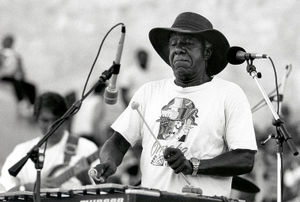It is similar in appearance to the xylophone, although the vibraphone uses metal bars instead of the wooden bars on the xylophone. The standard modern instrument has a range of three octaves, from the F below middle C. Larger four octave models from the C below middle C are also becoming more common. The vibraphone is commonly played with cord or yarn mallets.
Below each bar is a resonator, a resonant metal tube, with a metal disc of a slightly smaller diameter located at the top. The discs in each tube are connected via a rod which can be made to rotate with an electric motor. When the motor is on and a note is struck, the notes acquire a tremolo sound as the resonators are covered and uncovered by the rotating discs. The player can vary the speed of the tremolo. At slower speeds, the effect sounds more like a "wah-wah-wah." At faster speeds the tremolo is more pronounced. With the motor off, the vibraphone has a mellow, bell-like sound. The "vibrato" sound effect is what the vibraphone was named after. Because the amplitude is what varies, not the pitch, the name of the instrument is somewhat of a misnomer. The sound is dated and many modern vibists eschew the effect altogether.
The vibraphone also has a sustain pedal similar to that used on a piano. When the pedal is up, the bars are all damped and the sound of each bar is quite short; with the pedal down, they will sound for several seconds, so frequent rapid pedalling is common when playing a vibraphone.
The vibraphone was invented in the United States in 1921. It has a long history as a jazz instrument. However, the vibraphone has since been used in many other musical idioms, including popular music.
For a list of famous players, see vibraphonist.
Contents |
Technique
 Luigi Waites plays a vibraphone, July 29, 1999
Luigi Waites plays a vibraphone, July 29, 1999
As with the xylophone, early vibraphonists such as Lionel Hampton and Milt Jackson used two mallets to play the instrument. The instrument was primarily featured as solo instrument and contributed little to harmonic accompaniment. Modern vibraphonists such as Gary Burton, Mike Mainieri,Victor Feldman, Jerry Tachoir, Joe Locke and Dave Samuels, among others, use four mallets and the instrument has joined the modern jazz rhythm section as an accompaniment instrument. Often the vibes can substitute for a guitarist or pianist in this respect. The most common four-mallet grip used on the vibraphone is the Burton Grip named after Gary Burton. Five and six mallet grips are possible, but not as common, because using more mallets tends to adversely impact the player's ability to easily play melodic lines.
Phrasing is a constant consideration for the player due to the mechanics of the instrument. Vibraphone bars have an extremely long sustain time, often rivaling that of the electric guitar or piano. Unlike the piano, the vibraphone only allows for one sustain and dampening system: the sustain pedal and single dampening bar. With the pedal up, the notes played have an extremely staccato sound. Legato playing requires that the pedal be depressed, however this can lead to the notes bleeding together. To promote clarity in legato phrasing and prevent the notes of a melody from bleeding together, modern vibists employ the technique of mallet dampening. To do this, the vibist holds the pedal down and dampens the previous note in a melody with the head of the mallet when playing the subsequent note. This also allows the player to let a chord ring out while playing a melody line above it. This is another technical innovation introduced by Gary Burton.
One experimental technique is a note bend effect by sliding a mallet from the node (the portion of the bar through which the string passes) to the middle of the bar. While it does not actually bend the pitch, it does have the effect of filtering out the overtones. Another is using the bows of stringed instruments (such as a double bass bow) as an alternative way to cause the bars to vibrate.
Mike Mainieri, in 1964 invented the first pickup system for amplifying the vibes by glueing hot dot pickups on each nodal point of the bar. In the 70's Mainieri introduced the first monaural midi vibraphone and then in the 80's developed a polyphonic system that could trigger any synthesizer with a midi input. Since then other vibists have also experimented with incorporating electronics to the instrument. Some third-party companies market kits to add pickups to the bars, allowing electronic amplification and midi control.
Vibraphone performers
Gary Burton
Lionel Hampton
Bobby Hutcherson
Milt Jackson
Reg Kehoe and his Marimba Queens
Cal Tjader
Steve Shapiro
Roy Ayers
Media
-
Vibraphone Orchestra.ogg
- Footage from the early 1940s of an orchestra of xylophonists and a vibraphonist. (16.1 MB, ogg/Theora format).
See also
References
- Introduction to Jazz Vibes; by Gary Burton; Creative Music; 1965.
- Vibraphone Technique: Dampening and Pedaling; by David Friedman; Berklee Press Publications; 1973.
- Contemporary Mallet Method - An Approach to the Vibraphone and Marimba; by Jerry Tachoir: Riohcat Music; 1980
Categories: Idiophones




 216.73.216.190
216.73.216.190 User Stats:
User Stats:
 Today: 0
Today: 0 Yesterday: 0
Yesterday: 0 This Month: 0
This Month: 0 This Year: 0
This Year: 0 Total Users: 117
Total Users: 117 New Members:
New Members:
 216.73.xxx.xxx
216.73.xxx.xxx
 Server Time:
Server Time: